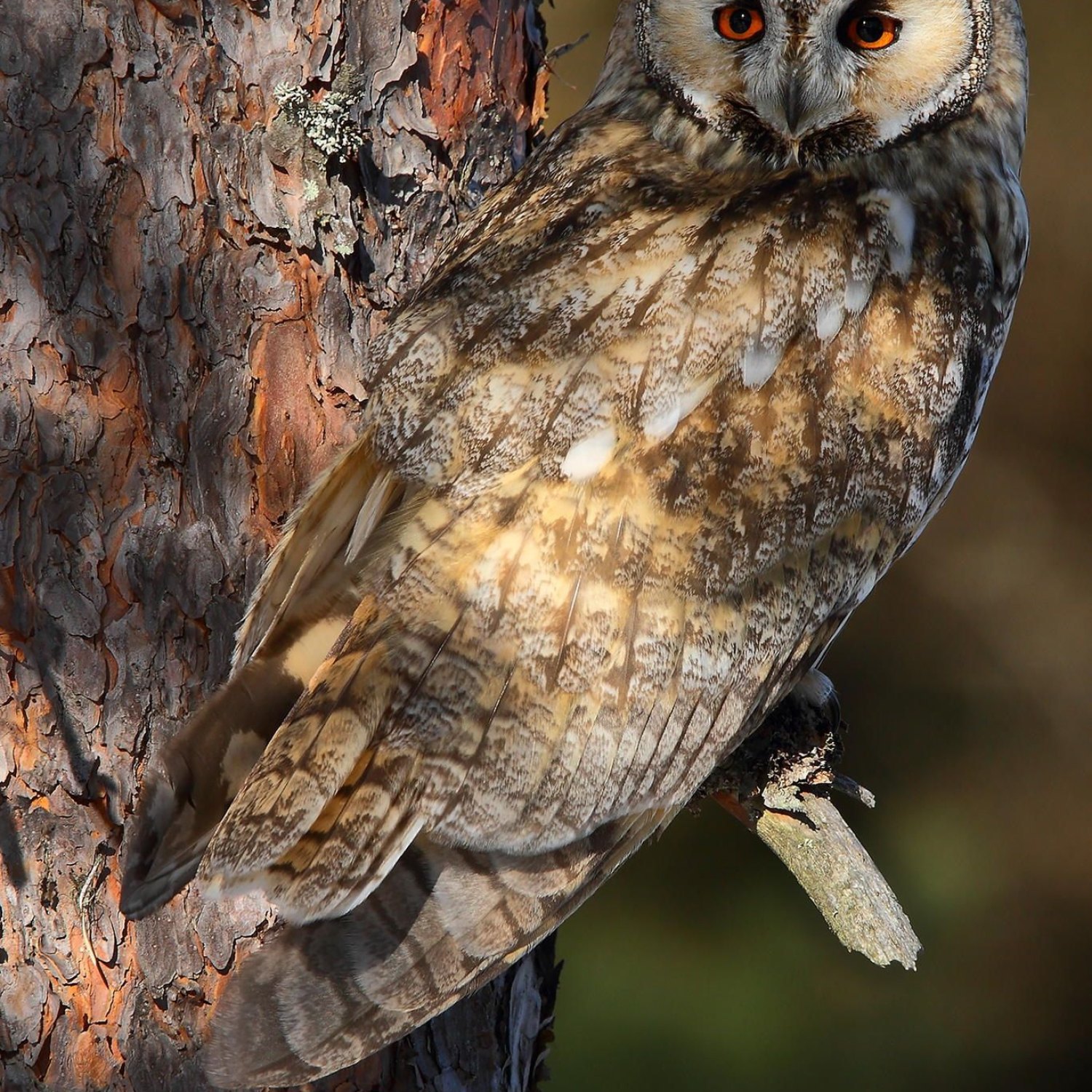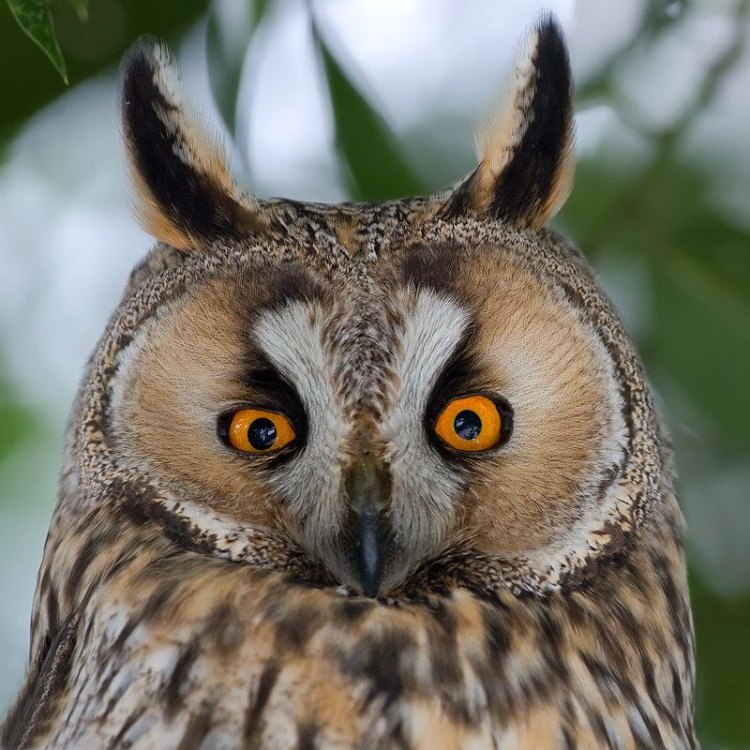
Long Eared Owl
13-16 inches
The Long Eared Owl, part of the Strigidae family, is a medium-sized owl known for its distinctive long ear tufts. Found in forests and woodlands, these birds can grow to be 13-16 inches in length. With a round head and striking appearance, they are often a favorite among bird enthusiasts. #LongEaredOwl #Strigidae #Owls #Birds #ForestAnimals
Animal Details Summary:
Common Name: Long Eared Owl
Kingdom: Animalia
Habitat: Wooded areas, forests, and open fields
The Mysterious World of the Long Eared Owl
Hiding in the shadows of forests, perched on the branches of trees and waiting for its prey with keen eyes, is the majestic long-eared owl. With its distinctive long ear tufts, and mesmerizing brown and white coloration, this bird is a sight to behold. However, despite its remarkable appearance, this owl is shrouded in mystery and often overlooked by many. In this article, we will delve into the lesser-known world of the long-eared owl, exploring its natural habitat, behaviors, and unique characteristics that make it a truly fascinating creature Long Eared Owl.Scientifically known as Asio otus, the long-eared owl is a member of the kingdom Animalia, the phylum Chordata, and the class Aves, making it part of the vast and diverse avian family. It belongs to the order Strigiformes, which includes other raptors such as owls, and the family Strigidae, which comprises many nocturnal birds of prey. The long-eared owl is distributed across the northern regions of North America, Europe, Asia, and Northern Africa, making it one of the most widely spread animals in the world. However, its range within these regions is limited to specific habitats, which we will explore in detail.
Habitat and Distribution
The long-eared owl is primarily found in wooded areas, including forests and open fields. These habitats provide the owl with sufficient coverage to hunt their prey, as well as suitable nesting sites. In North America, they are often spotted in coniferous forests, whereas in Europe, they inhabit deciduous forests. In Asia, they can be found in the dense woods of the Himalayan foothills, while in Northern Africa, they reside in the mountains and hills of Morocco and Algeria.
However, even within these regions, the long-eared owl is highly selective of its habitat Lobster. They prefer to inhabit dense woodlands with a mixture of trees, shrubs, and open spaces that offer diverse hunting opportunities. Interestingly, they also tend to avoid areas with deep snow cover, as it makes hunting difficult for them. This selective behavior makes it challenging to spot and study these elusive creatures, adding to their enigmatic nature.
Feeding Habits
Being a carnivorous species, the long-eared owl feeds on a variety of prey, including small mammals, birds, and insects. However, their diet mostly consists of small rodents such as mice, voles, and shrews, which are abundant in their wooded habitats. They hunt their prey at night, using their excellent hearing and sight to locate and capture their prey with precision. Their long, slender talons and sharp beaks are well adapted for hunting, allowing them to grasp and tear their prey apart efficiently.
However, the long-eared owl doesn't rely solely on its physical attributes for hunting. It also employs a unique hunting strategy known as "sycamore-fig" feeding, where it takes advantage of the hunting efforts of other birds. This behavior involves the owl following other predators, such as hawks or kestrels, who flush out small prey, allowing the long-eared owl to swoop in and catch its food. This behavior not only showcases the owl's cunning nature but also its ability to adapt and thrive in its environment.
Physical Characteristics
The long-eared owl has a medium-sized body, measuring approximately 13-16 inches in length, which makes it slightly smaller than other owl species. However, its most distinguishing feature is its long ear tufts that give the owl its name. These tufts are not its actual ears but rather feathers that are used for display, communication, and thermal regulation. When threatened, the owl will twist these tufts, making them appear even longer, to intimidate its predator. The tufts also help the owl blend into its surroundings, acting as camouflage and making it difficult to spot.
Apart from its long ear tufts, the long-eared owl also has a round head, big eyes, and a pointed beak, which are typical characteristics of most owl species. Its body is covered in soft and dense brown and white feathers, providing excellent insulation against the cold. This coloration also helps the owl blend into its environment and hide from predators during the day.
The Mysteries of Migration
One of the most intriguing aspects of the long-eared owl is its migration patterns. Unlike many other bird species, these owls do not migrate long distances every year. Instead, they follow an irregular migration pattern, where they only migrate when their food sources are scarce. This behavior is known as irruptive migration and is not well understood by scientists.
During these migratory movements, the long-eared owl often travels in large groups called irruptions, which can consist of hundreds or even thousands of birds. The cause of these irruptions is still unclear, but it is believed to be related to the availability of food sources. These movements take place in the fall and winter months and often result in the long-eared owl being sighted in new and unexpected locations, making them a rare sight for birdwatchers and nature enthusiasts.
Conservation Status
The long-eared owl has a vast global distribution, and its population is considered stable. However, like many other bird species, it does face some threats in the form of habitat loss and degradation. As human development continues to encroach on their habitats, these owls are forced to adapt to new and unfamiliar environments, which can be detrimental to their survival.
Conservation efforts, including habitat protection and education, are vital in ensuring the long-term survival of these owls. Fortunately, the long-eared owl is protected under the Migratory Bird Treaty Act in the United States, which prohibits the hunting, capture, or disturbance of the owls. This protection, along with other conservation efforts, has helped maintain a stable and healthy population of these magnificent creatures.
In Conclusion
The long-eared owl may be perceived as a simple and unremarkable owl by some, but it is, in fact, a complex and fascinating species with many unique features and behaviors. From its selective habitat and feeding habits to its mysterious migration patterns and irruptive movements, this owl continues to surprise and mystify researchers and nature enthusiasts alike. While its global population remains stable, it is essential to protect and preserve its habitats to ensure the long-term survival of this amazing bird. So, next time you are exploring a wooded area or forest, keep an eye out for the majestic long-eared owl – a creature that embodies the beauty and wonder of the natural world.

Long Eared Owl
Animal Details Long Eared Owl - Scientific Name: Asio otus
- Category: Animals L
- Scientific Name: Asio otus
- Common Name: Long Eared Owl
- Kingdom: Animalia
- Phylum: Chordata
- Class: Aves
- Order: Strigiformes
- Family: Strigidae
- Habitat: Wooded areas, forests, and open fields
- Feeding Method: Carnivorous
- Geographical Distribution: North America, Europe, Asia, and Northern Africa
- Country of Origin: United States
- Location: Forests and woodlands
- Animal Coloration: Brown and white
- Body Shape: Medium-sized owl with a round head and long ear tufts
- Length: 13-16 inches

Long Eared Owl
- Adult Size: Small to medium-sized owl
- Average Lifespan: 12-15 years
- Reproduction: Sexual
- Reproductive Behavior: Mating occurs in late winter to early spring
- Sound or Call: Males hoot with a low-pitched sound, females make a high-pitched scream
- Migration Pattern: Partially migratory
- Social Groups: Solitary
- Behavior: Nocturnal and highly territorial
- Threats: Habitat loss, urbanization, and collisions with vehicles
- Conservation Status: Least Concern
- Impact on Ecosystem: Predator of small mammals and birds
- Human Use: Popular bird for birdwatching
- Distinctive Features: Long ear tufts and orange eyes
- Interesting Facts: Long Eared Owls have excellent hearing and can locate prey in complete darkness.
- Predator: Larger owls, hawks, and mammals

Asio otus
The Elusive Hunter: Exploring the Unique Features of the Long Eared Owl
The forest is quiet and still as the sun sets, signaling the start of another night. But amidst the darkness and silence, a feathered hunter stirs. With its piercing orange eyes and long ear tufts, the Long Eared Owl takes to the skies, ready to hunt for its prey. This elusive predator may not be as well-known as its more popular cousins in the owl family, but it possesses unique features that make it a fascinating and formidable creature PeaceOfAnimals.Com. In this article, we will delve into the world of the Long Eared Owl, exploring its size, lifespan, reproductive behavior, migration patterns, social groups, behavior, threats, and conservation status, as well as its impact on the ecosystem and human use. But first, let us get to know this mysterious bird a little better.The Long Eared Owl (Asio otus), also known as the Northern Eared Owl, is a small to medium-sized owl that can be found in various parts of the world, including North America, Europe, and Asia. It is a member of the Strigidae family, which includes over 200 species of owls. Its scientific name, Asio otus, is derived from the Greek words "asio," which means "eared owl," and "otis," which translates to "a kind of bustard." This owl species is easily recognizable by its distinctive long ear tufts, which are not actually ears but just feathers that create the illusion of longer ears.
On average, Long Eared Owls measure between 13-16 inches in length, with a wingspan of 35-39 inches. They are relatively lightweight, weighing only about a pound, making them one of the smaller owls in their family. However, what they lack in size, they make up for in their remarkable abilities and unique features Lemon Cuckoo Bumblebee.
In the wild, Long Eared Owls have an average lifespan of 12-15 years, although some individuals have been known to live up to 20 years in captivity. Their mortality in the wild is mostly due to predators, human impact, and natural causes such as diseases and accidents. As with most animals, the lifespan of Long Eared Owls can be affected by various factors, such as food availability, climate, and habitat conditions.
Reproduction is a vital stage in an individual's life cycle, and for the Long Eared Owl, it follows a typical sexual behavior. Mating occurs in late winter to early spring, usually between February to April. During this period, the male will attract the female with a low-pitched hoot, while the female responds with a high-pitched scream. Unlike other species of owls, Long Eared Owls are monogamous, meaning they stay with the same partner for their entire breeding season.
After mating, the female will lay 4-14 eggs, which she will incubate for 26-28 days. The male plays a crucial role during this time, providing food for the female and helping raise the young once they hatch. The young owls, known as owlets, will leave the nest after about 26-30 days and become independent after 4-5 months. These young owls will reach sexual maturity and start breeding at around two years old.
One of the most intriguing characteristics of the Long Eared Owl is its migration pattern. It is considered partially migratory, meaning some individuals will migrate while others will remain in their breeding grounds year-round. This migration behavior depends on food availability and weather conditions. During winter, some owls will migrate to warmer areas, while others will stay in their breeding grounds, where they have established territories.
Speaking of territories, Long Eared Owls are highly territorial birds. They are solitary creatures and prefer to live and hunt alone. Each owl will have its own territory, ranging from 1-3 square miles, which it will defend fiercely from other owls. This territorial behavior is particularly evident during breeding season, as they become more vocal and aggressive towards intruders.
These elusive creatures are also known for their nocturnal behavior, making them an expert in hunting at night. They have excellent eyesight and can fly silently, allowing them to catch their prey by surprise. Long Eared Owls, like other owl species, have feathers specially designed for silent flight, allowing them to hunt without being detected. They are also equipped with incredibly sharp talons and excellent hearing, which they use to locate prey in complete darkness.
But, like many other animals, Long Eared Owls face a variety of challenges and threats in the wild. One of the primary threats to their survival is habitat loss and degradation. As urbanization and human development increase, their natural habitats, such as forests, woodlands, and grasslands, are being destroyed and fragmented. This decrease in suitable habitat results in a decline in prey species, making it harder for the owls to find food.
In addition to habitat loss, Long Eared Owls also face threats from urbanization, such as light pollution and urban noise, which can disrupt their natural behaviors and nesting patterns. Another significant threat in their habitat is collisions with vehicles, as the owls are often struck while hunting along roadsides.
Despite these threats, the International Union for Conservation of Nature (IUCN) currently lists the Long Eared Owl as a species of Least Concern. This means that their global population is considered stable, and they are not in immediate danger of extinction. However, continued efforts and conservation measures are necessary to ensure their numbers remain stable, and their habitats are protected.
As predators, Long Eared Owls play an essential role in maintaining the balance of the ecosystem. They primarily feed on small mammals and birds, such as mice, voles, shrews, and woodcocks. This hunting behavior helps to control the population of these prey species, which, in turn, affects the surrounding vegetation and other animals in the food chain. Thus, the presence of these owls is crucial in maintaining a healthy and diverse ecosystem.
Apart from their ecological impact, Long Eared Owls also have a significant impact on humans. Their unique features, such as their long ear tufts and bright orange eyes, make them a popular bird for birdwatching. People from all over the world visit their breeding grounds, hoping to catch a glimpse of these elusive creatures in action. These owl enthusiasts are often amazed by the owls' excellent hearing and hunting skills, making Long Eared Owls a favorite subject for nature photography and documentaries.
In conclusion, the Long Eared Owl may be a small and solitary creature, but it possesses unique features and abilities that make it a remarkable and formidable hunter. From its long ear tufts and orange eyes to its excellent hearing and hunting skills, this elusive bird has captivated the imagination of humans for centuries. However, their survival in the wild is threatened by habitat loss and human impact, making conservation efforts and protection of their habitats crucial in ensuring their continued existence. So, the next time you find yourself in a quiet forest at night, keep your eyes and ears open, and you might just get a glimpse of the elusive hunter, the Long Eared Owl.

The Mysterious World of the Long Eared Owl
Disclaimer: The content provided is for informational purposes only. We cannot guarantee the accuracy of the information on this page 100%. All information provided here may change without prior notice.












